 Dave Jenkinson, better known as Jenksie (or Jenks) and former Chief Observer for UK Competition Ballooning, as it was then, has entered the annals of ballooning history as being the only person ever to get a free balloon out of Camerons. Jenksie had entered ballooning in the mid eighties and came and crewed for some of the intrepid Black Horse flyers. He went on the get involved in Competition Ballooning by becoming an Observer and became highly respected in the sport being asked to be the Official Observer at many National and International Events including Record Attempts of various kinds. Times were hard (he was living off the cockroaches that lived under the fridge, they didn’t earn much) and it seemed he’d never actually get to own his own balloon but in 1991 the cockroaches moved out and set up on their own and Lady Luck paid him a visit.
Dave Jenkinson, better known as Jenksie (or Jenks) and former Chief Observer for UK Competition Ballooning, as it was then, has entered the annals of ballooning history as being the only person ever to get a free balloon out of Camerons. Jenksie had entered ballooning in the mid eighties and came and crewed for some of the intrepid Black Horse flyers. He went on the get involved in Competition Ballooning by becoming an Observer and became highly respected in the sport being asked to be the Official Observer at many National and International Events including Record Attempts of various kinds. Times were hard (he was living off the cockroaches that lived under the fridge, they didn’t earn much) and it seemed he’d never actually get to own his own balloon but in 1991 the cockroaches moved out and set up on their own and Lady Luck paid him a visit.
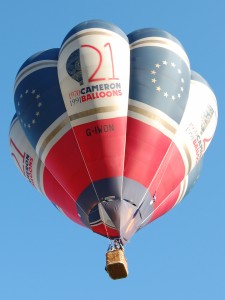 1991 marked the 21st Anniversary of Cameron Balloons and the launch of Bristol Belle so to celebrate the occasion Camerons built a special balloon that would tour the country (and world) promoting the company. A competition was organised where the total hours flown, up to the end of the Bristol Festival if his memory serves, had to be guessed. The nearest to the correct hours would be awarded the balloon and in the event of a draw then a tie-break Cameron jingle would decide. Entry forms to the competition flew off the shelves and the dealers handed them out to all and sundry. So it was that one evening down at the Black Horse that Peter Dowlen suggested everyone had a go. Jenksie stuffed his entry form in his back pocket and all but forgot about it. It wasn’t until he tipped them out prior to a Daz immersion he came across the scrumpled up entry form. Realising it was only a few days before entries closed he hastily had a read through, concocted a natty rhymn, ’21 years on from the Bristol Belle trust Camerons to excel’, had a stab at the hours and sent it off. Unsure, like the rest of the planet, about the likely number of hours that it would have done he recalled something he’d read in Aerostat about the competition that mentioned that it took eleven and a half minutes to rig and inflate it and that snippet of information would be helpful to contestants. “Right-ho chummies, I thought”, he explained, “Lets go for eleven and half hours, and I sent the form off with a day or two to spare.”
1991 marked the 21st Anniversary of Cameron Balloons and the launch of Bristol Belle so to celebrate the occasion Camerons built a special balloon that would tour the country (and world) promoting the company. A competition was organised where the total hours flown, up to the end of the Bristol Festival if his memory serves, had to be guessed. The nearest to the correct hours would be awarded the balloon and in the event of a draw then a tie-break Cameron jingle would decide. Entry forms to the competition flew off the shelves and the dealers handed them out to all and sundry. So it was that one evening down at the Black Horse that Peter Dowlen suggested everyone had a go. Jenksie stuffed his entry form in his back pocket and all but forgot about it. It wasn’t until he tipped them out prior to a Daz immersion he came across the scrumpled up entry form. Realising it was only a few days before entries closed he hastily had a read through, concocted a natty rhymn, ’21 years on from the Bristol Belle trust Camerons to excel’, had a stab at the hours and sent it off. Unsure, like the rest of the planet, about the likely number of hours that it would have done he recalled something he’d read in Aerostat about the competition that mentioned that it took eleven and a half minutes to rig and inflate it and that snippet of information would be helpful to contestants. “Right-ho chummies, I thought”, he explained, “Lets go for eleven and half hours, and I sent the form off with a day or two to spare.”
 By the time it got around to the 1991 Bristol Balloon Fiesta he was away in Tyndell, South Dakota, at the Thomas Soucup Museum Observing for a record lightweight Thunder & Colt Endurance and Distance attempt. Despite hanging on for a month the weather never played ball and it didn’t happen but one day a call came through. “Hey Jenksie, congratulations, you’ve won that balloon”. He couldn’t believe it but more importantly he was in the States and the balloon in Bristol. No problems he’d be presented with the keys at The Icicle. So it was that, to cheers and clapping, Cameron Balloons gave away their Anniversary Viva-90 serial number 2504 G-BTCV to a beaming and well made-up Jenksie and by February, with its new registration G-IWON, he was in the air in his own balloon. A dream come true.
By the time it got around to the 1991 Bristol Balloon Fiesta he was away in Tyndell, South Dakota, at the Thomas Soucup Museum Observing for a record lightweight Thunder & Colt Endurance and Distance attempt. Despite hanging on for a month the weather never played ball and it didn’t happen but one day a call came through. “Hey Jenksie, congratulations, you’ve won that balloon”. He couldn’t believe it but more importantly he was in the States and the balloon in Bristol. No problems he’d be presented with the keys at The Icicle. So it was that, to cheers and clapping, Cameron Balloons gave away their Anniversary Viva-90 serial number 2504 G-BTCV to a beaming and well made-up Jenksie and by February, with its new registration G-IWON, he was in the air in his own balloon. A dream come true.
So there we were having declared G-IWON fit for another year and discussing the B17 that crash-landed on Halton Airfield. “Never!” I hear you say, clearly a tale for another day, when Jenksie tells us his dad got shot down in a Halifax by an Me109 ‘Wild Boar’ night fighter. “Tell us more Jenksie,” we asked. Four hours later and he left forgetting the paperwork and the story was out. Seems his dad Philip was the mid-upper gunner aboard Halifax BII, ZA-G, JD166 of 10 squadron, which was then based at RAF Melbourne in Yorkshire, and off to bomb Munich on the night of September 6th 1943, coming in from South at 22,000 feet. They were attacked twice by what was thought to be ME109s. Jenksie’s dad and the rear gunner eventually shot the first one down but another, attacking from below, set the aircraft ablaze. He managed to bale out qualifying him for a prized Caterpillar Club pin with red eyes, presented to him by the Irving Parachute Company something he was very proud of. If you ever fancy an inspiring read look out for ‘Into the Silk’ by Ian Mackersey.
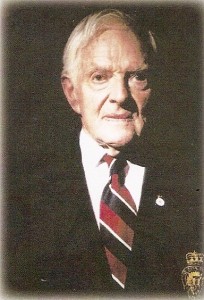 Jenksie’s dad, Philip, was born in Knightsbridge, London, on 15th May 1923 and christened Lesley Philip a name he didn’t take a fancy to. His early years were spent in Boxmoor and Old Fellcourt in Surrey. The family then moved to Cornwall, initially Mevagissey, then Bodmin Moor and then Bosvarren-Constantine near Falmouth. When war broke out he joined the LDV (Look, Duck and Vanish) which later became ‘Dad’s Army’ before enlising in the RAF as aircrew when he was sent off for training as an Air-gunner in Winnipeg, Canada. Returning to Britain on 2nd October 1942 aboard the Queen Mary, then the fastest troop ship in service, he witnessed the collision with HMS Curacoa. The light-cruiser was cut in half during the first zig-zag maneourve and sunk within six minutes with a loss of 239 lives including the captain, John Boutwood. The Queen Mary kept on going fearful of a U-boat attack. Back on terra-firma he found himself posted to RAF Melbourne with 4 Bomber Group, number 10 Squadron, the only bomber squadron to be based there. The Squadron flew 300 raids with loss of 128 Halifaxes. He had completed quite a few missions including one to Nurnberg on the night of the 10th-11th August 1943 aboard JD166. On the fateful night he was shot down 22 other aircraft were lost from which there were only 17 survivors.
Jenksie’s dad, Philip, was born in Knightsbridge, London, on 15th May 1923 and christened Lesley Philip a name he didn’t take a fancy to. His early years were spent in Boxmoor and Old Fellcourt in Surrey. The family then moved to Cornwall, initially Mevagissey, then Bodmin Moor and then Bosvarren-Constantine near Falmouth. When war broke out he joined the LDV (Look, Duck and Vanish) which later became ‘Dad’s Army’ before enlising in the RAF as aircrew when he was sent off for training as an Air-gunner in Winnipeg, Canada. Returning to Britain on 2nd October 1942 aboard the Queen Mary, then the fastest troop ship in service, he witnessed the collision with HMS Curacoa. The light-cruiser was cut in half during the first zig-zag maneourve and sunk within six minutes with a loss of 239 lives including the captain, John Boutwood. The Queen Mary kept on going fearful of a U-boat attack. Back on terra-firma he found himself posted to RAF Melbourne with 4 Bomber Group, number 10 Squadron, the only bomber squadron to be based there. The Squadron flew 300 raids with loss of 128 Halifaxes. He had completed quite a few missions including one to Nurnberg on the night of the 10th-11th August 1943 aboard JD166. On the fateful night he was shot down 22 other aircraft were lost from which there were only 17 survivors.
The Handley Page Halifax started life in 1935 as the HP56, a twin engine design,  but by the time the prototype flew in 1940 it had evolved into the HP57, a four engined heavy bomber. The aircraft was officially named the Halifax by Lord Halifax, some say after his wife, but others quote the Yorkshire phrase ‘From Hell, Hull and Halifax the good Lord deliver us’. In truth heavy bombers were traditionally named after major towns. Halifax ZA-G, JD 166 was a Mk II and fitted with Merlins. It was built by the English Electric Co Ltd, (one of 350 aircraft of Contract No. ACFT/1808). Deliveries commenced 21/2/43 so it was still pretty new. The Halifax has often been regarded as the poor relation of the Lancaster but actually that was far from the truth. The early versions were a tad underpowered, more through drag problems caused by prop-wash over the leading edge rather than anything else, but the Mk II had the more powerful Merlin 20s, an upper turret and a curved nose rather than the front turret. What they did lack were proper exhaust flame dampers which made them very visible at night.
but by the time the prototype flew in 1940 it had evolved into the HP57, a four engined heavy bomber. The aircraft was officially named the Halifax by Lord Halifax, some say after his wife, but others quote the Yorkshire phrase ‘From Hell, Hull and Halifax the good Lord deliver us’. In truth heavy bombers were traditionally named after major towns. Halifax ZA-G, JD 166 was a Mk II and fitted with Merlins. It was built by the English Electric Co Ltd, (one of 350 aircraft of Contract No. ACFT/1808). Deliveries commenced 21/2/43 so it was still pretty new. The Halifax has often been regarded as the poor relation of the Lancaster but actually that was far from the truth. The early versions were a tad underpowered, more through drag problems caused by prop-wash over the leading edge rather than anything else, but the Mk II had the more powerful Merlin 20s, an upper turret and a curved nose rather than the front turret. What they did lack were proper exhaust flame dampers which made them very visible at night.
 As the bombing raids over Germany intensified and the radar and radar deflection systems improved it was becoming harder and harder for the German defences to deal with them so they introduced the ‘Wild Boar’ night fighters. Rather than scramble a mass of fighters that then found themselves attacking a decoy they just let the fighters go off and find the bombers. These were mainly Bf109s, Me110s and Fw 190s and they had a high success rate. With the help of the 10 Squadron Association we found out that if it was indeed a Bf-109 that JD166 beat off it was flown by either Lt Walter Harjes (1./JG 300)
As the bombing raids over Germany intensified and the radar and radar deflection systems improved it was becoming harder and harder for the German defences to deal with them so they introduced the ‘Wild Boar’ night fighters. Rather than scramble a mass of fighters that then found themselves attacking a decoy they just let the fighters go off and find the bombers. These were mainly Bf109s, Me110s and Fw 190s and they had a high success rate. With the help of the 10 Squadron Association we found out that if it was indeed a Bf-109 that JD166 beat off it was flown by either Lt Walter Harjes (1./JG 300) or Uffz Alfons Zeder (2./JG 300). The second attack from below, which bought the Halifax down may have also been an Me-109, quite what the facts are will never be known but JD166 was burning badly and going down. The majority of the bombs were jettisoned or fell out as a result of the fire and the crew of seven, apart from the pilot, A. G. Douglas and rear gunner P. C. Okill, managed to parachute out. JD166 finally crashed in a field close to Leeder north of Shongau and burnt out.
or Uffz Alfons Zeder (2./JG 300). The second attack from below, which bought the Halifax down may have also been an Me-109, quite what the facts are will never be known but JD166 was burning badly and going down. The majority of the bombs were jettisoned or fell out as a result of the fire and the crew of seven, apart from the pilot, A. G. Douglas and rear gunner P. C. Okill, managed to parachute out. JD166 finally crashed in a field close to Leeder north of Shongau and burnt out.
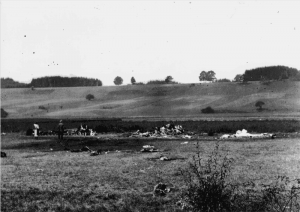 Jenksie’s dad landed by parachute in the early hours, quite close to the crash site and close by a wood. Following a track he met up with the bomb-aimer, the regular bomb aimer having been stood down for the mission (a bad omen) and hearing a train they headed for it, found a railway line and followed it through to Kempten and then decided to head south for Switzerland. Nine days later they had reached Immenstadt and, just short of the border, bedraggled, hungry and tired they were picked up by the local police and became prisoners of war.
Jenksie’s dad landed by parachute in the early hours, quite close to the crash site and close by a wood. Following a track he met up with the bomb-aimer, the regular bomb aimer having been stood down for the mission (a bad omen) and hearing a train they headed for it, found a railway line and followed it through to Kempten and then decided to head south for Switzerland. Nine days later they had reached Immenstadt and, just short of the border, bedraggled, hungry and tired they were picked up by the local police and became prisoners of war.
After the war ended he was ferried home aboard a Dakota and continued to serve in 511 Squadron, initially on Avro Yorks in the newly formed Transport Command based in Lyneham and then went out to the Middle and Far East. Following demobilisation he worked on a chicken farm at Urchfont in Wiltshire owned by a certain A. G. Street, a well-known broadcaster of the day. Things went well and he purchased a farm at Chulmliegh in North Devon and in 1955 moved to Aslcott Farm in Shebbear, Devon.
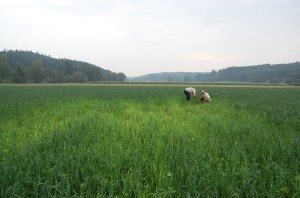 Ever since his escape from the Halifax and his eventual capture he always wanted to return to the site and try and find out what happened to the rest of the crew. With the help of the local farmer and his family, with whom he became life-long friends, he soon discovered the crash site. He was taken to the field where his plane had come down and to his astonishment was informed that the location was very easy to spot as the crop on the actual crash site was always much poorer than the rest of the field, probably as a result of the phosphorous from the remaining bomb load.
Ever since his escape from the Halifax and his eventual capture he always wanted to return to the site and try and find out what happened to the rest of the crew. With the help of the local farmer and his family, with whom he became life-long friends, he soon discovered the crash site. He was taken to the field where his plane had come down and to his astonishment was informed that the location was very easy to spot as the crop on the actual crash site was always much poorer than the rest of the field, probably as a result of the phosphorous from the remaining bomb load.  They then presented him with some photographs of the crash site taken the following day and the later recovery of the remains. Despite the German military picking up most of the wreckage, simply walking the field he found plenty of aluminium debris and even some spent shell cases from the position of the upper turret, certainly ones that he had fired. He was also shown a line of craters from the bombs that fell from his stricken aircraft.
They then presented him with some photographs of the crash site taken the following day and the later recovery of the remains. Despite the German military picking up most of the wreckage, simply walking the field he found plenty of aluminium debris and even some spent shell cases from the position of the upper turret, certainly ones that he had fired. He was also shown a line of craters from the bombs that fell from his stricken aircraft.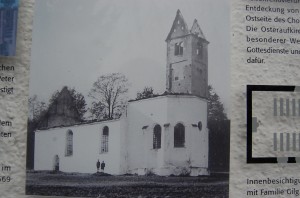 All bar one landed in open countryside but in the middle of nowhere at the end of the line of craters was a church. The last bomb hit it and it was destroyed. He discovered that the pilot and rear-gunner went down in the aircraft and it transpired that the Flight Engineer and another crew-member, probably the navigator, made for the airfield at Landsberg and, it was claimed, attempted to steal an aircraft. Sadly they vanished without trace. It was a most strange and poignant time and as a result of his new found friends he went back every year. With the help of German air historian
All bar one landed in open countryside but in the middle of nowhere at the end of the line of craters was a church. The last bomb hit it and it was destroyed. He discovered that the pilot and rear-gunner went down in the aircraft and it transpired that the Flight Engineer and another crew-member, probably the navigator, made for the airfield at Landsberg and, it was claimed, attempted to steal an aircraft. Sadly they vanished without trace. It was a most strange and poignant time and as a result of his new found friends he went back every year. With the help of German air historian  Hans Griminger he managed to trace the burial place of the pilot and rear gunner to Durnbach War Cemetery near Bad Tolz, the only one in Southern Bavaria. Now this is where things start getting really strange. His brother, Peter, was shot down and killed on his 30th mission in a Lancaster and his whereabouts were never ascertained. When Jenksie’s old man visited the graves of Douglas and Okill in 1952, immediately behind them, in the next row, was the grave of his brother and crew of the Lancaster.
Hans Griminger he managed to trace the burial place of the pilot and rear gunner to Durnbach War Cemetery near Bad Tolz, the only one in Southern Bavaria. Now this is where things start getting really strange. His brother, Peter, was shot down and killed on his 30th mission in a Lancaster and his whereabouts were never ascertained. When Jenksie’s old man visited the graves of Douglas and Okill in 1952, immediately behind them, in the next row, was the grave of his brother and crew of the Lancaster.
Over the years he collected quite a bit of wreckage, some identifiable, and eventually he reckoned he had enough to have a model 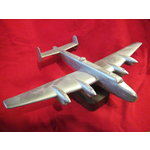 of his Halifax cast in the aluminium he had collected. In fact it turned out he had enough for three. With a wingspan of 16 inches they are pretty impressive. The models were cast by the Tiercel Art Foundry in Exeter. Number One went to his dad, Number Three to the Manston Spitfire and Hurricane Museum and Number Two was auctioned quite recently, buyer unknown.
of his Halifax cast in the aluminium he had collected. In fact it turned out he had enough for three. With a wingspan of 16 inches they are pretty impressive. The models were cast by the Tiercel Art Foundry in Exeter. Number One went to his dad, Number Three to the Manston Spitfire and Hurricane Museum and Number Two was auctioned quite recently, buyer unknown.
Philip Jenkinson passed away on 13th December 2011. Following his funeral and cremation Jenksie, along with the German family that had befriended him, arranged to have half his ashes buried at his brother’s grave opposite those of his pilot and rear gunner on 6th September the anniversary of the day he took off for the raid on Germany and was shot down. The remaining ashes were spread at his Devon farm.
along with the German family that had befriended him, arranged to have half his ashes buried at his brother’s grave opposite those of his pilot and rear gunner on 6th September the anniversary of the day he took off for the raid on Germany and was shot down. The remaining ashes were spread at his Devon farm.
These days RAF Melbourne has returned to agriculture however, the runway patterns still remain and part of one runway is home to the Yorkshire Raceway drag racing strip and the control tower has been converted to a family home. The church they accidentally hit was rebuilt and Philip was there for the blessing of the bells.  In very strange circumstances, much later in his life following a road accident, he finally met up with Kevin Murphy again, his Navigator that fateful night. Having been rendered unconscious in the crash the first thing he asked when he came to was, “Where’s Kevin Murphy? Is he OK?” Following some delving he was found to alive and well and living in St Albans until he passed away in about 2008. There are no Halifaxes left flying however there are a few survivors. Yorkshire Air Museum at Elvington has rebuilt one from parts various. In 1984 Halifax HR792’s rear fuselage was found on Stornaway, With parts from many crash sites, Hastings’ wings and new bits and bobs this was the first true representation of complete, restored Halifax anywhere in the world. In the RAF Museum at Hendon is a Halifax in its ‘as found’ state having been raised from Lake Hoklingen in Norway after crash landing on the ice with its wing ablaze after a raid on the Tirpitz in 1942. In Canada another Halifax has been restored. Karl Kjarsgaard (A Canadian airline pilot) had heard of a Canadian special duties Halifax that had been found 40 years after it had ditched in a Lake Mjosa in Norway. In 1995 It was, raised, dismantled and returned to Canada, where the most remarkable restoration has now taken place. At the Imperial War Museum there is the nose section of a Halifax you can actually walk through. 10 Squadron re-formed officially on 1 August 2011 with the Airbus A330 Voyager tanker and transport aircraft. The Squadron Standard was reconsecrated at RAF Cranwell, earlier on 1 June and the first aircraft arrived at RAF Brize Norton and completed its first official Squadron flight on Easter Sunday, April 2012.
In very strange circumstances, much later in his life following a road accident, he finally met up with Kevin Murphy again, his Navigator that fateful night. Having been rendered unconscious in the crash the first thing he asked when he came to was, “Where’s Kevin Murphy? Is he OK?” Following some delving he was found to alive and well and living in St Albans until he passed away in about 2008. There are no Halifaxes left flying however there are a few survivors. Yorkshire Air Museum at Elvington has rebuilt one from parts various. In 1984 Halifax HR792’s rear fuselage was found on Stornaway, With parts from many crash sites, Hastings’ wings and new bits and bobs this was the first true representation of complete, restored Halifax anywhere in the world. In the RAF Museum at Hendon is a Halifax in its ‘as found’ state having been raised from Lake Hoklingen in Norway after crash landing on the ice with its wing ablaze after a raid on the Tirpitz in 1942. In Canada another Halifax has been restored. Karl Kjarsgaard (A Canadian airline pilot) had heard of a Canadian special duties Halifax that had been found 40 years after it had ditched in a Lake Mjosa in Norway. In 1995 It was, raised, dismantled and returned to Canada, where the most remarkable restoration has now taken place. At the Imperial War Museum there is the nose section of a Halifax you can actually walk through. 10 Squadron re-formed officially on 1 August 2011 with the Airbus A330 Voyager tanker and transport aircraft. The Squadron Standard was reconsecrated at RAF Cranwell, earlier on 1 June and the first aircraft arrived at RAF Brize Norton and completed its first official Squadron flight on Easter Sunday, April 2012.
Dave Jenks still has his VW pickup with its purpose-built back 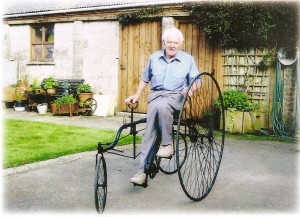 and G-IWON is still going strong with over 300 hours on the clock. Remarkable for a Viva! To pass his time and earn a pound Dave Jenksie runs an irrigation company called In-x-scapes, specialising in domestic and commercial irrigation, private gardens, football pitches, bowling greens, hanging baskets and trendy living green walls and can be contacted on mobile 07774 265 242 in times of drought.
and G-IWON is still going strong with over 300 hours on the clock. Remarkable for a Viva! To pass his time and earn a pound Dave Jenksie runs an irrigation company called In-x-scapes, specialising in domestic and commercial irrigation, private gardens, football pitches, bowling greens, hanging baskets and trendy living green walls and can be contacted on mobile 07774 265 242 in times of drought.
http://www.10sqnass.co.uk/ RAF 10 Squadron Association
www.yorkshireairmuseum.org/ Elvington Yorkshire
http://www.rafmuseum.org.uk/ RAF Hendon
http://www.iwm.org.uk/ Imperial War Museum
http://www.youtube.com/watch?v=tY8OMDWqreo walk through of the Elvington Halifax
http://www.youtube.com/watch?v=svdCsMvRAYQ bit of footage of Halifaxes in flight